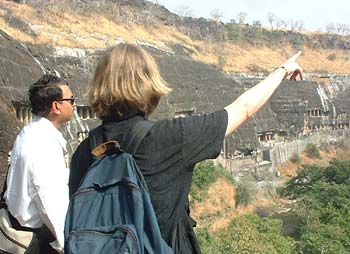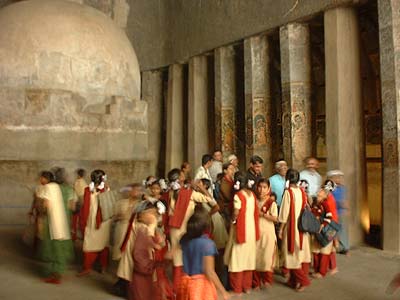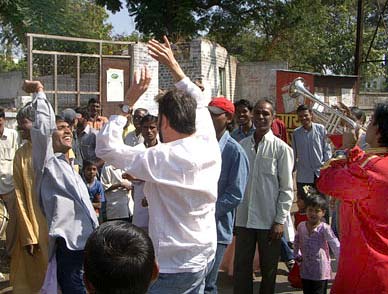The Digs Around Aurangabad
(Dec. 24-26, 2003)
 |
|
Glorian and Dr. Pradip Bhalde, an archeological expert, survey the cliff face at Ajanta. Ajanta has 27 caves. These temples went for centuries unnoticed, hidden behind the undergrowth, until an English soldier spotted the top of one the temple openings through the trees in 1819. |
We went to Aurangabad for a taste of history. We were dazzled by what we found, and it was much more than history.
Aurangabad is a central location for visiting the temple-caves at Ellora and Ajanta. The Ellora caves include Buddhist (600 to 800 AD), Hindu (up to about 900 AD), and Jain (800 to 1000 AD) temples, sculpted out of the mountainside. They're called "caves," which sounds kind of dank and claustrophobic. A better term would be something like "cliff temples"; they're stone temples carved out of solid bedrock. Imagine Mount Rushmore, except executed on a grander scale, and constructed without resorting to kitsch or dynamite. Any one of these caves would be a tourist destination in most parts of the world. Ajanta has 27 caves. Ellora has 34.
Most amazing of all is the Hindu temple called Kailasa – it is a rock sculpture cut down into the mountainside from about four stories deep into the mountain rock. The temple buildings are all intricately sculpted, the sculptures telling the stories of the Hindu gods shaped in the rock in elaborate detail, with marks of the colorful paint that once was there.
 |
|
Schoolchildren are frequent visitors to the temples at Ellora and Ajanta. |
The Ajanta caves are earlier – built between 200 BC and 650 AD. These temples went for centuries unnoticed, hidden behind the undergrowth, until an English soldier spotted the top of one the temple openings through the trees in 1819. Imagine that – it makes us wonder what other remnants of past civilizations are buried beneath trees – or have perished without a trace over the millennia due to earthquakes, war, or erosion. At any rate, it was being hidden and unused that saved the paintings inside the temples, still quite well-preserved after two thousand years: that is what makes these temples so spectacular. Our expert guide, Mr. Pradip, was able to lead us through the paintings, explaining the Buddhist stories represented there. He also told us that the earlier caves were simple and fairly austere, representing the earlier forms of Buddhism that allowed no images of Buddha, and only very simple structures. But, according to Mr. Pradeep, it was necessary for Buddhist tradition to compete with their Hindu surroundings – if they were to find followers, they needed similar paintings, images, and stories to attract the people, for the Hindus love their stories and festivals and celebrations. This early form of competitive marketing is visible in the transition in Buddhism represented on the walls of these caves, with the stories of the many incarnations of Buddha and his followers. All these stories of pantheons of deities is a bit of reminiscent of Greek mythology, and indeed, there are some similar story lines.
It seems so much of our travels here are highlighted by our interactions with people. Funny little interactions: a classroom of schoolgirls surrounded us on the balcony of the Kailasa temple. Their teacher came forward – "These girls want to know what country you are from." The girls all came close to shake our hands, explaining in their newly-learned English that they were from a village in Gujarat, all welcoming us to India.
I got a different type of greeting as I started the march up the hill toward the Ajanta caves. "Ma’am, would you like a chair?" They wanted me to ride in the chair as they carried me up the mountain! Oh, I must be looking old!
 |
|
"Sir, I am the brother of the groom and I would like to dance with you." |
We also got whisked into a wedding. What an amazing experience. As part of Hindu tradition, the wedding begins with the groom being brought to the bride (usually on horseback, but it could be on an elephant or in a fancy car) as part of a festive procession through the streets - a party in motion. We encountered just such a procession in a non-touristed part of Aurangabad; the wedding party was taking the groom on horseback to the wedding, playing music and dancing in the street along the way. We watched for a while, and then Hank had to plunge in to take a few pictures. After the party had passed by, two young men came up to him - "Sir, I am the brother of the groom and I would like to dance with you." I think that may have been the first time Hank was ever asked to dance by a man. What could we do? We joined the party! So, first, Hank danced with the young men. Then the whole party joined in, and of course pulled me into it all - young ladies, an old man, a neighborhood boy, all dancing with me, laughing, taking photos, with the groom laughing and enjoying the whole scene from atop his horse. Then of course they placed the flower garlands around our necks, placed a dollop of red paint on our foreheads and topped it with glitter, and laughing, we all parted company, waving. The generosity and inclusiveness of spirit is incredible.
<Home
more pictures>